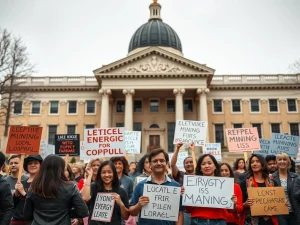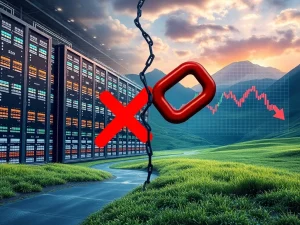Urgent Rush for Mining Rigs? US Crypto Miners Face Tariff Disadvantage Despite Trump’s Pause

The rollercoaster ride for US crypto miners continues as Donald Trump’s administration announces a 90-day pause on hefty tariffs. Is this a golden opportunity or a fleeting moment of relief? Industry insiders suggest a mixed bag – a potential short-term buying frenzy for mining rigs, overshadowed by a persistent ‘clear disadvantage’ due to baseline levies. Let’s dive into what this tariff pause really means for the future of Bitcoin mining in the USA.
Will US Crypto Miners Trigger a Mining Rig Buying Spree?
The recent tariff pause initiated by Donald Trump’s administration has sparked discussions about a potential surge in mining rigs acquisitions by US crypto miners. While the pause offers a temporary reprieve from escalating tariffs, a baseline 10% tariff remains in place for most countries, excluding China which faces a staggering 145% rate. This situation presents a complex landscape for the US Bitcoin mining industry.
Jaran Mellerud, CEO of Hashlabs, points out that while the 10% tariff is significantly less burdensome than the hiked rates, it still positions US miners at a disadvantage compared to their international counterparts when procuring mining machines. According to Mellerud, this baseline tariff, though not crippling, elevates capital expenditure and casts a shadow on the long-term profitability of new investments in the sector.
Key Takeaway: The tariff pause might trigger a short-term rush to import mining rigs as US crypto miners attempt to capitalize on the window before potential future tariff hikes. However, the existing 10% baseline tariff still puts them at a competitive disadvantage.
The Looming Disadvantage: Baseline Tariffs and Long-Term Viability
Despite the tariff pause offering a moment of respite, the underlying 10% tariffs continue to pose a challenge for US Bitcoin mining operations. Ethan Vera, COO of Luxor Technology, confirms that the price of mining rigs destined for the US is already on the rise. This price increase is fueled by miners eager to purchase machines before any further tariff escalations and the higher costs associated with onshore assembly contracts.
Consider these factors contributing to the ‘clear disadvantage’ for US miners:
- Elevated Capital Expenditure: Even a 10% tariff adds a significant layer of cost to mining rigs, increasing the initial investment required for operations.
- Competitive Pressure: Miners in regions with zero or lower tariffs have a cost advantage, potentially leading to greater profitability and faster expansion.
- Long-Term Investment Concerns: The ongoing tariff uncertainty and baseline levies can deter long-term investments in US Bitcoin mining infrastructure.
Example: Imagine two mining firms, one in the US and one in a country with no tariffs. Both want to purchase the same mining rigs. The US firm will pay 10% more upfront due to the tariff, impacting their cash flow and potentially their ability to scale as quickly.
Trump’s Tariff Policy: A Whirlwind of Uncertainty for Bitcoin Mining
The Trump administration’s approach to tariffs has been described as ‘policy whiplash’ by industry experts. The sudden imposition of tariffs on Thailand, Indonesia, and Malaysia – key manufacturing hubs for mining rigs – followed by a subsequent pause, has created significant instability. Prior to the pause, tariffs reached staggering levels: 36% on Thailand, 32% on Indonesia, and 24% on Malaysia.
Jaran Mellerud highlighted in a previous report that these abrupt tariff hikes could decimate US demand for mining rigs. Manufacturers, facing reduced US orders, would likely divert their surplus inventory to non-US markets at discounted prices, further disadvantaging US miners in the long run.
The Impact of Policy Instability:
- Hurt Growth: Unpredictable tariff policies stifle growth and investment in the US Bitcoin mining sector.
- Strategic Rethinking: Companies like Luxor are reconsidering their US-centric strategies and exploring international expansion to mitigate risks associated with US policy uncertainty.
- Erosion of Predictability: Bitcoin mining businesses thrive on predictability and stable regulatory environments. The current policy volatility undermines long-term planning and investment confidence.
“Made in the USA” Bitcoin: A Vision vs. Tariff Reality
Despite the tariff turbulence, Donald Trump has publicly expressed his ambition to have all remaining Bitcoin “made in the USA.” Furthermore, members of the Trump family have partnered with Hut 8 to launch “American Bitcoin,” a venture aiming to establish the world’s largest Bitcoin mining operation with strategic reserves.
However, Ethan Vera argues that the crypto mining industry is likely not a “high priority” within the broader scope of Trump’s tariff policies. The tariffs, while broad-reaching, seem to be driven by wider trade and economic considerations rather than specific targeting of the Bitcoin mining sector.
Contradictions and Challenges:
- Policy vs. Ambition: While the “Made in USA” Bitcoin vision is appealing, the current tariff regime creates headwinds for domestic miners.
- Market Impact: Trump’s tariffs have broadly impacted markets, including crypto, as evidenced by Bitcoin’s price fluctuations.
- Global Competition: The US Bitcoin mining industry operates in a global market. Tariffs that disadvantage US miners could inadvertently strengthen competitors in other regions.
Navigating the Tariff Maze: The Path Forward for US Crypto Miners
The tariffs, while paused, have injected a dose of uncertainty into the US Bitcoin mining landscape. While a short-term surge in mining rigs imports might materialize, the underlying challenges remain. US crypto miners must navigate this complex environment by:
- Strategic Procurement: Optimizing mining rigs purchases to leverage tariff pauses and potentially explore alternative sourcing strategies.
- Advocacy and Engagement: Engaging with policymakers to advocate for stable and predictable regulations that support the growth of the US Bitcoin mining industry.
- Operational Efficiency: Focusing on operational excellence and cost optimization to mitigate the impact of tariffs and maintain competitiveness.
- International Diversification: Considering international expansion to hedge against domestic policy risks and tap into more favorable regulatory environments.
In Conclusion: The tariff pause offers a temporary window of opportunity for US crypto miners to acquire mining rigs. However, the baseline tariffs and the broader policy uncertainty cast a shadow on the long-term prospects of the industry. For US Bitcoin mining to truly thrive and fulfill the “Made in USA” vision, a more stable and supportive policy framework is essential. The current situation demands resilience, strategic adaptation, and proactive engagement from US crypto miners to navigate the tariff maze and secure their future in the global Bitcoin mining arena.









